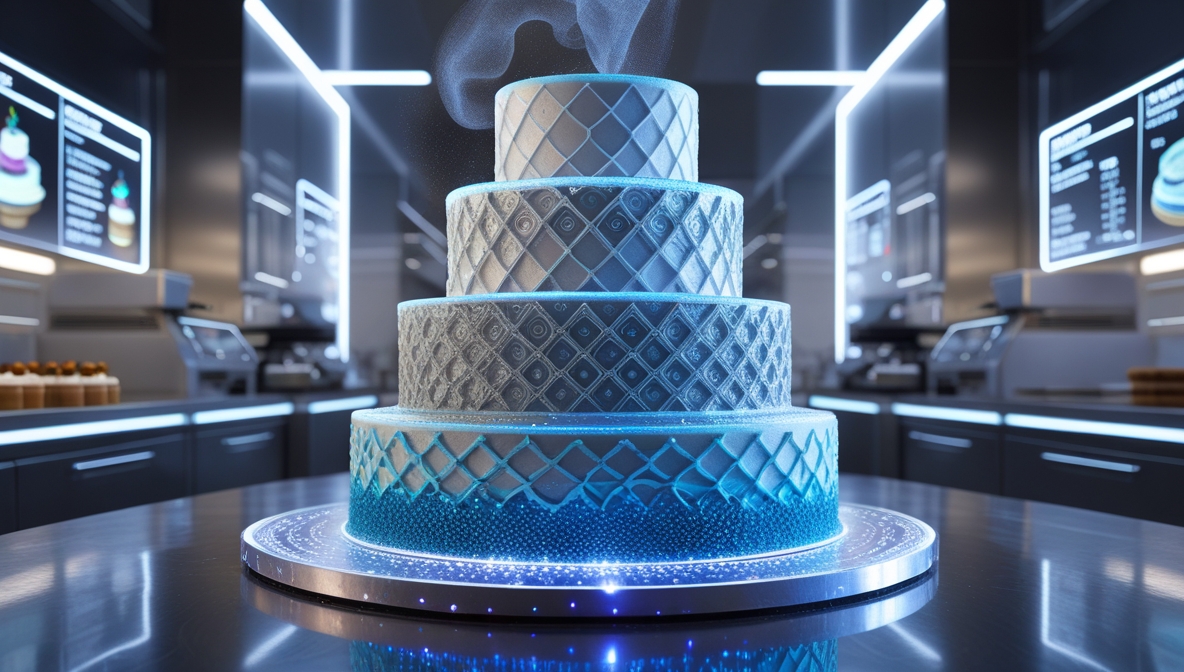3D Printed Cakes: The Future of Baking?

Introduction
Technology has reshaped almost every industry, and now it’s making its way into the world of baking. Imagine a cake not baked in an oven but designed on a computer and printed layer by layer with precision. That’s the magic of 3D-printed cakes. But is this just a passing trend, or are we witnessing the future of baking? Let’s dive into the world of 3D food printing and explore its potential impact on the baking industry.
What Are 3D Printed Cakes?
3D-printed cakes are desserts created using a specialized food printer instead of traditional baking methods. These printers use edible materials—like chocolate, fondant, or cake batter—to build intricate designs that would be nearly impossible to achieve by hand. The process allows bakers and food artists to create customized, detailed cakes with exceptional precision and creativity.
How Does 3D Cake Printing Work?

Step-by-Step Process
- Designing the Cake: The first step involves creating a digital blueprint of the cake using specialized 3D modeling software.
- Choosing Ingredients: Edible printing materials such as chocolate, icing, or cake batter are selected.
- Layer-by-Layer Printing: The food printer deposits layers of the chosen material based on the digital design, shaping the cake precisely.
- Final Touches: Once printing is complete, bakers may add additional decorations, colors, or textures to enhance the appearance.
Benefits of 3D Printed Cakes

1. Precision and Intricate Designs
3D printing enables bakers to create cakes with incredibly detailed and complex designs that would be challenging to replicate by hand.
2. Enhanced Creativity
From futuristic sculptures to geometrically perfect shapes, 3D printing opens up endless possibilities for cake decoration and presentation.
3. Time Efficiency
While intricate cake designs often take hours (or even days) to craft manually, 3D printing speeds up the process, making it easier to fulfill large-scale orders quickly.
4. Reduced Waste
Traditional baking often results in excess ingredients or discarded trimmings. With 3D printing, ingredients are used precisely, minimizing food waste.
Customization & Design Possibilities

One of the most exciting aspects of 3D cake printing is the ability to customize cakes to the tiniest detail. Customers can design their own cakes online, choosing specific patterns, colors, and even personalized messages to be printed directly onto the cake. Whether it’s a wedding cake with intricate lace patterns or a child’s birthday cake shaped like their favorite cartoon character, the possibilities are endless.
Challenges and Limitations
1. High Costs
3D food printers are still relatively expensive, making them less accessible to small bakeries and home bakers.
2. Limited Ingredients
Not all cake components can be 3D printed. Soft cake layers still need to be traditionally baked, as 3D printing works best with chocolate, fondant, and other paste-like materials.
3. Texture and Taste Considerations
While visually stunning, some 3D-printed cakes might lack the fluffy, airy texture of traditionally baked cakes.
3D Printed Cakes vs. Traditional Cakes
| Feature | 3D Printed Cakes | Traditional Cakes |
|---|---|---|
| Customization | Highly detailed and customizable | Limited by manual skills |
| Production Time | Faster for intricate designs | Time-consuming |
| Taste & Texture | May differ from baked cakes | Classic texture and flavor |
| Cost | Higher initial cost | More affordable |
The Future of 3D Cake Printing

With continuous advancements in food technology, 3D cake printing is expected to become more accessible and widely used. We may see bakeries integrating food printers for custom orders, restaurants offering unique 3D-printed desserts, and even households experimenting with 3D-printed treats at home. As the technology improves, costs are likely to decrease, making it a viable option for more bakers and dessert lovers.
Is It Worth Trying?
3D-printed cakes are an exciting innovation, especially for those who love personalized and artistic desserts. While traditional cakes remain irreplaceable for their taste and texture, 3D printing adds a new dimension to cake artistry, making it a valuable tool for creative bakers. If you enjoy unique, customized treats and futuristic food trends, 3D-printed cakes are definitely worth exploring!
Conclusion
The world of baking is evolving, and 3D-printed cakes represent an exciting glimpse into the future. While there are some challenges, the advantages of precision, customization, and efficiency make this a technology worth watching. Whether for weddings, birthdays, or special events, 3D-printed cakes are paving the way for a new era in dessert design.
FAQs About 3D Printed Cakes
1. Can I eat a 3D-printed cake?
Yes! 3D-printed cakes are made with edible ingredients like chocolate, fondant, and cake batter.
2. How long does it take to print a cake?
It depends on the complexity of the design. Simple shapes may take minutes, while intricate cakes can take hours.
3. Are 3D food printers affordable?
Currently, they are expensive, but prices may decrease as the technology becomes more mainstream.
4. Can 3D printing replace traditional baking?
Not entirely. While it offers new possibilities for decoration and precision, traditional baking is still essential for soft cake layers.
5. Where can I try a 3D-printed cake?
Some high-end bakeries and food technology companies offer 3D-printed cakes. Check online for locations near you!
